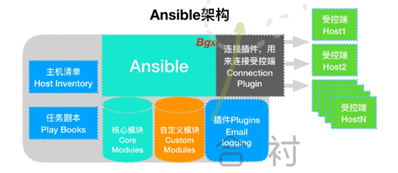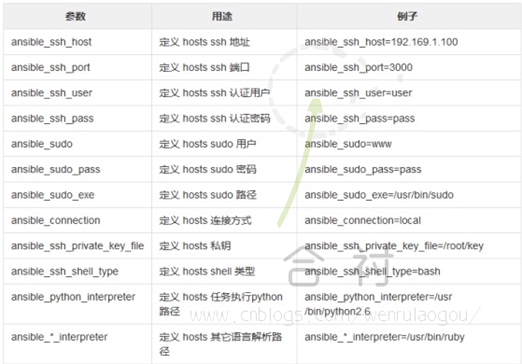CentOS7.5 -- Ansible部署與應用
第1章 Ansible概述
Ansible是一個配置管理系統configuration management system
python 語言是運維人員必須會的語言
ansible 是一個基於python 開發的自動化運維工具
其功能實現基於ssh遠端連線服務
ansible 可以實現批量系統配置,批量軟體部署,批量檔案拷貝,批量執行命令等功能
除了ansible之外,還有saltstack 等批量管理軟體
1.1 Ansible能做什麼
ansible可以幫助我們完成一些批量任務,或者完成一些需要經常重複的工作。 比如:同時在100臺伺服器上安裝nginx服務,並在安裝後啟動服務。 比如:將某個檔案一次性拷貝到100臺伺服器上。 比如:每當有新伺服器加入工作環境時,你都要為新伺服器部署某個服務,也就是說你需要經常重複的完成相同的工作。 這些場景中我們都可以使用到ansible。
1.2 Ansible軟體特點
1.ansible不需要單獨安裝客戶端,SSH相當於ansible客戶端。 2.ansible不需要啟動任何服務,僅需安裝對應工具即可。 3.ansible依賴大量的python模組來實現批量管理。 4.ansible配置檔案/etc/ansible/ansible.cfg
1.3 Ansible基礎架構

1.連線外掛(connectior plugins) 用於連線主機 用來連線被管理端 2.核心模組(core modules) 連線主機實現操作, 它依賴於具體的模組來做具體的事情 3.自定義模組(custom modules) 根據自己的需求編寫具體的模組 4.外掛(plugins) 完成模組功能的補充 5.劇本(playbooks)ansible的配置檔案,將多個任務定義在劇本中,由ansible自動執行 6.主機清單(host inventory)定義ansible需要操作主機的範圍 最重要的一點是 ansible是模組化的 它所有的操作都依賴於模組
不需要單獨安裝客戶端(no agents),基於系統自帶的sshd服務,sshd就相當於ansible的客戶端
不需要服務端(no sever)
需要依靠大量的模組實現批量管理
配置檔案 /etc/ansible/ansible.cfg (前期不用配置)
1.4 ansible中檢視模組
[[email protected] ~]# ansible-doc -l 列出所有模組資訊 [[email protected] ~]# ansible-doc -s cron 參看指定模組的幫助
第2章 Ansible部署與使用
2.1 ansible命令語法格式

[[email protected] ~]# ansible oldboy -m command -a "hostname" 10.0.0.31 | SUCCESS | rc=0 >> backup 10.0.0.41 | SUCCESS | rc=0 >> nfs01
2.2 Ansible清單管理
inventory檔案通常用於定義要管理主機的認證資訊, 例如ssh登入使用者名稱、密碼以及key相關資訊。如何配置Inventory檔案
主機
1.支援主機名通配以及正則表示式,例如web[1:3].oldboy.com 2.支援基於非標準的ssh埠,例如web1.oldboy.com:6666 3.支援指定變數,可對個別主機的特殊配置,如登陸使用者,密碼等
主機組
1.支援巢狀組,例如[game:children],那麼在game模組下面的組都會被game所包含 2.支援指定變數,例如[game:vars]在下面指定變數
以下操作都是在/etc/ansible/hosts 完成的
新增三臺主機至webserver [webservers] web1.oldboy.com web2.oldboy.com web3.oldboy.com 新增三臺主機至webserver[low改良版] [webservers] web[1:3].oldboy.com 新增三臺主機至webserver[密碼版] [webservers] web1.oldboy.com ansible_ssh_pass='123456' web2.oldboy.com ansible_ssh_pass='123456' web3.oldboy.com ansible_ssh_pass='123456' 新增三臺主機至webserver[密碼改良版] [webservers] web[1:3].oldboy.com ansible_ssh_pass='123456' 新增三臺主機至webserver[密碼拆分版] [webservers] web1.oldboy.com web2.oldboy.com web3.oldboy.com [webservers:vars] ansible_ssh_pass='123456' 定義多組,多組彙總整合 [apache] web1.oldboy.com web2.oldboy.com web3.oldboy.com [apache:vars] ansible_ssh_pass='123456' [nginx] 10.0.0.7 10.0.0.31 10.0.0.41 10.0.0.61 [nginx:vars] ansible_ssh_pass='123456' webservers組包括兩個子組[apapche,nginx] [webservers:children] apache nginx ansible nginx --list-hosts ansible apache --list-hosts ansible websers --list-hosts
2.3 Ansible安裝配置
實現從管理機m01到其他機器的金鑰認證
說明:
ansible其功能實現基於SSH遠端連線服務
使用ansible需要首先實現ssh金鑰連線
ansible藉助公鑰批量管理
ssh服務分發公鑰實質執行過程
①. 管理伺服器建立私鑰和公鑰(金鑰對) ②. 將公鑰檔案遠端傳送複製到被管理伺服器相應使用者~/.ssh/id_dsa.pub下,並修改.ssh目錄許可權為700 ③. 修改公鑰檔案檔名稱為authorized_keys,授權許可權為600 ④. 利用ssh服務配置檔案的配置引數,進行識別公鑰檔案authorized_keys ⑤. 進而實現基於金鑰遠端登入伺服器(免密碼登入/非互動方式登入)
-P指定密碼 -f指定存放的位置 [[email protected] ~]# ssh-keygen -t rsa 一直回車直到結束即可 Generating public/private dsa key pair. Enter file in which to save the key (/root/.ssh/id_dsa): #私鑰建立後儲存的路徑 Created directory '/root/.ssh'. Enter passphrase (empty for no passphrase): #私鑰需不需進行加密,設定密碼 Enter same passphrase again: #私鑰需不需進行加密,再次輸入密碼確認 ssh-keygen -P "" -f ~/.ssh/id_rsa 非互動式建立密碼 [[email protected] ~]# ll .ssh/ total 8 -rw------- 1 root root 1679 Sep 11 03:15 id_rsa #創建出來的私鑰 -rw-r--r-- 1 root root 390 Sep 11 03:15 id_rsa.pub #創建出來的公鑰 #利用非交換式工具實現批量分發公鑰與批量管理伺服器 [[email protected] ~]# ssh-copy-id -i ~/.ssh/id_rsa.pub [email protected] [[email protected] ~]# ssh-copy-id -i ~/.ssh/id_rsa.pub [email protected] -i 指定要分發的公鑰檔案以及路徑資訊 [[email protected]] 以什麼使用者身份進行分發 machine 將公鑰分發到哪臺主機上,遠端主機IP地址
2.3.1 安裝ansible
[[email protected] ~]# yum install ansible -y 檢查ansible版本 [[email protected] ~]# ansible --version ansible 2.6.1
2.3.2 配置ansible
軟體安裝完成,進行修改ansible下的hosts檔案,注意檔案的路徑
[[email protected] ~]# vim /etc/ansible/hosts [oldboy] 172.16.1.31 172.16.1.41
【】中的名字代表組名
主機(hosts)部分可以使用域名、主機名、IP地址表示;一般此類配置中多使用IP地址;
組名下的主機地址就是ansible可以管理的地址
至此ansible 服務就部署完成
2.3.3 驗證ansible
ansible是通過ssh埠探測通訊
[[email protected] ~]# ansible oldboy -m ping 10.0.0.30 | SUCCESS => { "changed": false, "ping": "pong" } 10.0.0.40 | SUCCESS => { "changed": false, "ping": "pong" }
2.4 /etc/ansible下的檔案
[[email protected] ansible]# ll total 28 -rw-r--r-- 1 root root 18066 Sep 6 06:38 ansible.cfg #ansible配置檔案 -rw-r--r-- 1 root root 1016 Sep 6 06:38 hosts #定義ansible可以管理的主機資訊 drwxr-xr-x 2 root root 4096 Sep 6 06:38 roles #主要在自動化的時候部署多臺主機時使用
2.5 Ansible內建變數

2.6 Ansible常用模組
在ansible中是指需要快速執行一條命令, 並且不需要儲存的命令,對於複雜的命令則為playbook
Ansible注意事項->提示顏色資訊說明
黃色:對遠端節點進行相應修改 綠色:對遠端節點不進行相應修改,或者只是對遠端節點資訊進行檢視 紅色:操作執行命令有異常 紫色:表示對命令執行發出警告資訊(可能存在的問題,給你一下建議)
2.6.1 command與shell
command模組 預設模組, 執行命令 [[email protected] ~]# ansible oldboy -a "hostname" shell模組 如果需要一些管道操作,則使用shell [[email protected] ~]# ansible oldboy -m shell -a "ifconfig|grep eth0" -f 50 # -f =forks /etc/ansible/ansible.cfg #結果返回的數量
2.6.2 yum安裝模組
推送指令碼檔案至遠端,遠端執行指令碼檔案
[[email protected] ~]# ansible oldboy -m yum -a "name=httpd state=installed" name ---指定要安裝的軟體包名稱 state ---指定使用yum的方法 installed,present ---安裝軟體包 removed,absent ---移除軟體包 latest ---安裝最新軟體包
2.6.3 copy模組
推送檔案模組
[[email protected] ~]# ansible oldboy -m copy -a "src=/etc/hosts dest=/tmp/test.txt"
在推送覆蓋遠端端檔案前,對遠端已有檔案進行備份,按照時間資訊備份
[[email protected] ~]# ansible oldboy -m copy -a "src=/etc/hosts dest=/tmp/test.txt backup=yes"
直接向遠端檔案內寫入資料資訊,並且會覆蓋遠端檔案內原有資料資訊
[[email protected] ~]# ansible oldboy -m copy -a "content='bgx' dest=/tmp/oldboy"
src --- 推送資料的原始檔資訊
dest --- 推送資料的目標路徑
backup --- 對推送傳輸過去的檔案,進行備份
content --- 直接批量在被管理端檔案中新增內容
group --- 將本地檔案推送到遠端,指定檔案屬組資訊
owner --- 將本地檔案推送到遠端,指定檔案屬主資訊
mode --- 將本地檔案推送到遠端,指定檔案許可權資訊
2.6.4 service服務模組
[[email protected] ~]# ansible oldboy -m service -a "name=crond state=stopped enabled=yes"
name --- 定義要啟動服務的名稱
state --- 指定服務狀態是停止或是執行,停止和執行指令要寫成過去時
started --- 啟動
stopped --- 停止
restarted --- 重啟
reloaded --- 過載
enabled --- 是否讓服務開啟自啟動
2.6.5 script模組
編寫指令碼
[[email protected] ~]# mkdir -p /server/scripts [[email protected] ~]# cat /server/scripts/yum.sh #!/usr/bin/bash yum install -y iftop
在本地執行模組,等同於在遠端執行,不需要將指令碼檔案進行推送目標主機執行
[[email protected] ~]# ansible oldboy -m script -a "/server/scripts/yum.sh"
2.6.6 file配置模組
[[email protected] ~]# ansible oldboy -m file -a "path=/tmp/oldboy state=diretory" [[email protected] ~]# ansible oldboy -m file -a "path=/tmp/tt state=touch mode=555 owner=root group=root" [[email protected] ~]# ansible oldboy -m file -a "src=/tmp/tt path=/tmp/tt_link state=link"
path --- 指定遠端主機目錄或檔案資訊
recurse --- 遞迴授權
state ---
directory --- 在遠端建立目錄
touch --- 在遠端建立檔案
link --- link或hard表示建立連結檔案
absent --- 表示刪除檔案或目錄
mode --- 設定檔案或目錄許可權
owner --- 設定檔案或目錄屬主資訊
group --- 設定檔案或目錄屬組資訊
2.6.7 group模組
name --- 指定建立的組名
gid --- 指定組的gid
state
absent --- 移除遠端主機的組
present --- 建立遠端主機的組(預設)
建立組,指定gid
[[email protected] ~]# ansible oldboy -m group -a "name=oldgirl gid=888"
2.6.8 user模組
[[email protected] ~]# echo "bgx"| openssl passwd -1 -stdin $1$1KmeCnsK$HGnBE86F/XkXufL.n6sEb. [[email protected] ~]# ansible oldboy -m user -a 'name=xlw password="$1$1KmeCnsK$HGnBE86F/XkXufL.n6sEb."' 建立oldgirl,設定uid為888,並加入gid為888 [[email protected] ~]# ansible oldboy -m user -a "name=oldgirl uid=888 group=888 shell=/sbin/nologin create_home=no" 隨機生成加密字串(-1使用MD5進行加密 -stdin 非互動式 -salt 加密引數) [[email protected] ~]# echo "bgx" | openssl passwd -1 -stdin 固定加密字串 [[email protected] ~]# echo "123"| openssl passwd -1 -stdin -salt 'salt 建立普通使用者,並配置對應的使用者密碼 [[email protected] ~]# echo "bgx" | openssl passwd -1 -stdin $1$1KmeCnsK$HGnBE86F/XkXufL.n6sEb. [[email protected] ~]# ansible oldboy -m user -a 'name=xlw password="$1$765yDGau$diDKPRoCIPMU6KEVEaPTZ0"'
uid --- 指定使用者的uid
group --- 指定使用者組名稱
groups --- 指定附加組名稱
password --- 給使用者新增密碼
shell --- 指定使用者登入shell
create_home --- 是否建立家目錄
2.6.9 crond模組
正常使用crond服務
[[email protected] ~]# crontab -l * * * * * /bin/sh /server/scripts/yum.sh
使用ansible新增一條定時任務
[[email protected] ~]# ansible oldboy -m cron -a "minute=* hour=* day=* month=* weekday=* job='/bin/sh /server/scripts/test.sh'" [[email protected] ~]# ansible oldboy -m cron -a "job='/bin/sh /server/scripts/test.sh'"
設定定時任務註釋資訊,防止重複,name設定
[[email protected] ~]# ansible oldboy -m cron -a "name='cron01' job='/bin/sh /server/scripts/test.sh'"
刪除相應定時任務
[[email protected] ~]# ansible oldboy -m cron -a "name='ansible cron02' minute=0 hour=0 job='/bin/sh /server/scripts/test.sh' state=absent"
註釋相應定時任務,使定時任務失效
[[email protected] scripts]# ansible oldboy -m cron -a "name='ansible cron01' minute=0 hour=0 job='/bin/sh /server/scripts/test.sh' disabled=no"
minute 分 Minute when the job should run ( 0-59, *, */2, etc )
hour 時 Hour when the job should run ( 0-23, *, */2, etc )
day 日 Day of the month the job should run ( 1-31, *, */2, etc )
month 月 Month of the year the job should run ( 1-12, *, */2, etc )
weekday 周 Day of the week that the job should run ( 0-6 for Sunday-Saturday, *, etc )
job 工作 ;要做的事情
name 定義定時任務的描述資訊
disabled 註釋定時任務
state
absent 刪除定時任務
present 建立定時任務(預設為present)
2.6.10 mount模組
僅將掛載的配置寫入/etc/fstab,並不會執行掛載操作
[[email protected] ~]# ansible oldboy -m mount -a "src=172.16.1.31:/data path=/data fstype=nfs opts=defaults state=present"
臨時掛載裝置,並將掛載資訊寫入/etc/fstab
[[email protected] ~]# ansible web -m mount -a "src=172.16.1.31:/data path=/data fstype=nfs opts=defaults state=mounted"
臨時解除安裝,不會清理/etc/fstab
[[email protected] ~]# ansible web -m mount -a "src=172.16.1.31:/data path=/data fstype=nfs opts=defaults state=unmounted"
解除安裝,不僅臨時解除安裝,同時會清理/etc/fstab
[[email protected] ~]# ansible web -m mount -a "src=172.16.1.31:/data path=/data fstype=nfs opts=defaults state=absent"
present ---開機掛載,僅將掛載配置寫入/etc/fstab(不常用)
mounted ---掛載裝置,並將配置寫入/etc/fstab
unmounted ---解除安裝裝置,不會清除/etc/fstab寫入的配置
absent ---解除安裝裝置,會清理/etc/fstab寫入的配置
第3章 ansible-playbook
playbook是由一個或多個模組組成的,使用多個不同的模組,完成一件事情。
3.1 ansible軟體特點
可以實現批量管理
可以實現批量部署
ad-hoc(批量執行命令)---針對臨時性的操作 ansible clsn -m command -a "hostname" <- 批量執行命令舉例
編寫劇本-指令碼(playbook)---針對重複性的操作
3.2 ansible核心功能
pyYAML-----用於ansible編寫劇本所使用的語言格式(saltstack---python) rsync-ini語法 sersync-xml語法 ansible-pyYAML語法 paramiko---遠端連線與資料傳輸 Jinja2-----用於編寫ansible的模板資訊
第4章 劇本編寫規則說明
4.1 YAML三板斧
縮排
YAML使用一個固定的縮排風格表示層級結構,每個縮排由兩個空格組成, 不能使用tabs
冒號
以冒號結尾的除外,其他所有冒號後面所有必須有空格。
短橫線
表示列表項,使用一個短橫槓加一個空格。
多個項使用同樣的縮排級別作為同一列表。
4.2 劇本書寫格式
- hosts: 172.16.1.7 處理指定伺服器 (空格)hosts:(空格)172.16.1.7
task: 劇本所要乾的事情; (空格)(空格)task:
- name: (兩個空格)-(空格)name:
command: echo hello clsn linux (四個空格)command:(空格)
劇本格式示例
[[email protected] ansible-playbook]# vim rsync.yaml - hosts: 172.16.1.41 tasks: - name: Install Rsync yum: name=rsync state=installed
4.3 劇本檢查方法
ansible-playbook --syntax-check 01.yml --- 進行劇本配置資訊語法檢查 ansible-playbook -C 01.yml --- 模擬劇本執行(彩排)
4.3.1 語法檢查
ansible-playbook --syntax-check [[email protected] ansible-playbook]# ansible-playbook --syntax-check 01.yml playbook: 01.yml
4.3.2 模擬劇本執行
ansible-playbook -C [[email protected] ansible-playbook]# ansible-playbook -C 01.yml PLAY [all] **************************************************************** TASK [Gathering Facts] **************************************************** ok: [172.16.1.41] ok: [172.16.1.8] 此處省略……….. PLAY RECAP **************************************************************** 172.16.1.31 : ok=2 changed=0 unreachable=0 failed=0 172.16.1.41 : ok=2 changed=0 unreachable=0 failed=0 172.16.1.8 : ok=2 changed=0 unreachable=0 failed=0
4.4 劇本示例
劇本編寫內容擴充套件:劇本任務編寫多個任務
- hosts: all tasks: - name: restart-network cron: name='restart network' minute=00 hour=00 job='/usr/sbin/ntpdate time.nist.gov >/dev/null 2>&1' - name: sync time cron: name='sync time' minute=*/5 job="/usr/sbin/ntpdate pool.ntp.com >/dev/null 2>&1"
劇本編寫內容擴充套件:劇本任務編寫多個主機
- hosts: 172.16.1.7 tasks: - name: restart-network cron: name='restart network' minute=00 hour=00 job='/usr/sbin/ntpdate time.nist.gov >/dev/null 2>&1' - name: sync time cron: name='sync time' minute=*/5 job="/usr/sbin/ntpdate pool.ntp.com >/dev/null 2>&1" - hosts: 172.16.1.31 tasks: - name: show ip addr to file shell: echo $(hostname -i) >> /tmp/ip.txt
4.5 劇本編寫方式
多主機單任務編寫方式
多主機多工編寫方式
不同主機多工編寫方式
第5章 Ansible專案案例
5.1 環境規劃
全網備份
實時備份
|
角色 |
外網IP(NAT) |
內網IP(LAN) |
部署軟體 |
|
m01 |
eth0:10.0.0.61 |
eth1:172.16.1.61 |
ansible |
|
backup |
eth0:10.0.0.41 |
eth1:172.16.1.41 |
rsync |
|
nfs |
eth0:10.0.0.31 |
eth1:172.16.1.31 |
nfs、Sersync |
|
web01 |
eth0:10.0.0.7 |
eth1:172.16.1.7 |
httpd |
5.2 目錄規劃
[[email protected] ~]# mkdir /etc/ansible/ansible_playbook/{file,conf,scripts} -p [[email protected] ~]# tree /etc/ansible/ansible_playbook/ /etc/ansible/ansible_playbook/ ├── conf └── file └── scripts
5.3 需提前準備好的檔案
5.3.1 rsync配置檔案
準備對應的配置檔案存放至/etc/ansible/ansible_playbook/conf/

[[email protected] conf]# cat /etc/ansible/ansible_playbook/conf/rsyncd.conf uid = www gid = www port = 873 fake super = yes use chroot = no max connections = 200 timeout = 600 ignore errors read only = false list = false auth users = rsync_backup secrets file = /etc/rsync.password log file = /var/log/rsyncd.log ##################################### [backup] path = /backup [data] path = /dataView Code
5.3.2 nfs配置檔案
準備nfs配置檔案exports

[[email protected] ansible_playbook]# cat /etc/ansible/ansible_playbook/conf/nfs_exports /data/ 172.16.1.0/24(rw,sync,all_squash,anonuid=666,anongid=666)View Code
5.3.3 Sersync軟體包
下載Sersync軟體包

[[email protected] ansible_playbook]# ll /etc/ansible/ansible_playbook/file/ -rw-r--r-- 1 root root 727290 Aug 1 12:04 sersync.tar.gzView Code
5.3.4 sersync配置檔案
準備sersync實時同步的配置檔案

[[email protected] ansible_playbook]# cat /etc/ansible/ansible_playbook/conf/confxml.xml.nfs <?xml version="1.0" encoding="ISO-8859-1"?> <head version="2.5"> <host hostip="localhost" port="8008"></host> <debug start="false"/> <fileSystem xfs="true"/> <filter start="false"> <exclude expression="(.*)\.svn"></exclude> <exclude expression="(.*)\.gz"></exclude> <exclude expression="^info/*"></exclude> <exclude expression="^static/*"></exclude> </filter> <inotify> <delete start="true"/> <createFolder start="true"/> <createFile start="true"/> <closeWrite start="true"/> <moveFrom start="true"/> <moveTo start="true"/> <attrib start="false"/> <modify start="false"/> </inotify> <sersync> <localpath watch="/data"> <remote ip="172.16.1.41" name="data"/> </localpath> <rsync> <commonParams params="-az"/> <auth start="true" users="rsync_backup" passwordfile="/etc/rsync.pass"/> <userDefinedPort start="false" port="874"/><!-- port=874 --> <timeout start="true" time="100"/><!-- timeout=100 --> <ssh start="false"/> </rsync> <failLog path="/tmp/rsync_fail_log.sh" timeToExecute="60"/><!--default every 60mins execute once--> <crontab start="false" schedule="600"><!--600mins--> <crontabfilter start="false"> <exclude expression="*.php"></exclude> <exclude expression="info/*"></exclude> </crontabfilter> </crontab> <plugin start="false" name="command"/> </sersync> <plugin name="command"> <param prefix="/bin/sh" suffix="" ignoreError="true"/> <!--prefix /opt/tongbu/mmm.sh suffix--> <filter start="false"> <include expression="(.*)\.php"/> <include expression="(.*)\.sh"/> </filter> </plugin> <plugin name="socket"> <localpath watch="/opt/tongbu"> <deshost ip="192.168.138.20" port="8009"/> </localpath> </plugin> <plugin name="refreshCDN"> <localpath watch="/data0/htdocs/cms.xoyo.com/site/"> <cdninfo domainname="ccms.chinacache.com" port="80" username="xxxx" passwd="xxxx"/> <sendurl base="http://pic.xoyo.com/cms"/> <regexurl regex="false" match="cms.xoyo.com/site([/a-zA-Z0-9]*).xoyo.com/images"/> </localpath> </plugin> </head>View Code
5.4 基礎環境部署
基礎環境:所有機器統一的配置
1.需要關閉firewalld以及selinux、epel倉庫、ssh埠、優化基礎配置
2.需要安裝rsync和nfs-utils
3.準備www使用者
4.需要準備/etc/rsync.pass密碼檔案
5.需要準備全網備份指令碼

基礎的playbook劇本 [[email protected] ansible_playbook]# cat base.yaml - hosts: all tasks: - name: Install Epel Repos get_url: url=http://mirrors.aliyun.com/repo/epel-7.repo dest=/etc/yum.repos.d/epel.repo - name: Install Rsync Nfs-Utils yum: name=rsync,nfs-utils state=installed - name: Create Group WWW group: name=www gid=666 - name: Create User WWW user: name=www uid=666 group=666 create_home=no shell=/sbin/nologin - name: Create Rsync_Client_Pass copy: content='1' dest=/etc/rsync.pass mode=600 - name: Create Scripts Directory file: path=/server/scripts recurse=yes state=directory - name: Push File Scripts copy: src=./scripts/rsync_backup_md5.sh dest=/server/scripts/ - name: Crontable Scripts cron: name="backup scripts" hour=01 minute=00 job="/bin/bash /server/scripts/rsync_backup_md5.sh &>/dev/null"View Code
5.5 應用環境:Rsync
1.安裝rsync
2.配置rsync(配置變更,一定要進行過載操作)
3.建立虛擬使用者,許可權調整
4.建立目錄/data/ /backup
5.啟動rsync
6.配置郵箱->郵箱的發件人->校驗的指令碼

[[email protected] ansible_playbook]# cat rsync.yaml - hosts: backup tasks: - name: Installed Rsync Server yum: name=rsync,mailx state=installed - name: configure Rsync Server copy: src=./conf/rsyncd.conf dest=/etc/rsyncd.conf notify: Restart Rsync Server - name: Create Virt User copy: content='rsync_backup:1' dest=/etc/rsync.password mode=600 - name: Create Data file: path=/data state=directory recurse=yes owner=www group=www mode=755 - name: Create Backup file: path=/backup state=directory recurse=yes owner=www group=www mode=755 - name: Start RsyncServer service: name=rsyncd state=started enabled=yes - name: Push Check Scripts copy: src=./scripts/rsync_check_backup.sh dest=/server/scripts/ - name: Crond Check Scripts cron: name="check scripts" hour=05 minute=00 job="/bin/bash /server/scripts/rsync_check_backup.sh &>/dev/null"View Code
5.6 應用環境:NFS
1.安裝nfs-utils
2.配置nfs (當修改了配置,觸發過載操作)
3.建立目錄,授權
4.啟動

[[email protected] ansible_playbook]# cat nfs.yaml - hosts: nfs tasks: - name: Installed Nfs Server yum: name=nfs-utils state=installed - name: Configure Nfs Server copy: src=./conf/exports dest=/etc/exports notify: Restart Nfs Server - name: Create Share Data file: path=/data state=directory recurse=yes owner=www group=www mode=755

